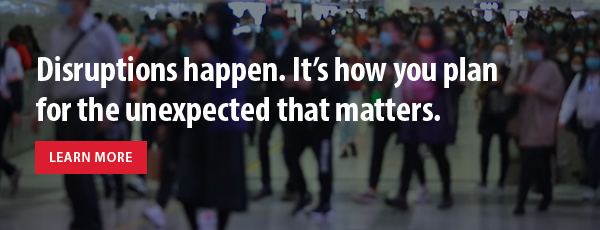
It’s difficult to be fully prepared for such an extreme event as the COVID-19 outbreak, but some supply chains were more prepared than others. Some companies went on offense. Many others were forced to play defense. Anyone that could connect the nodes in their supply chain from customers down to tier two and three suppliers had a leg up. As well, anyone with advanced scenario planning capabilities was better positioned to quickly model impact and responses.
However, even those companies that previously made advances in their supply chain performance couldn’t escape the challenges that came from extreme demand changes and supply disruptions. This means all companies will be conducting post-pandemic boardroom sessions to ready their supply chains for the next major event. If we’ve learned anything it’s not if something like this will happen again but when will it happen. A second wave of COVID-19 and more social distancing measures are likely, according to some health experts.
There will be much to discuss in the boardroom. Below are some of the topics likely to be top of mind for supply chain leaders when it comes to being pandemic-ready:
- Global network visibility. It will be important to map your network to understand where there may be risk at any tier in any location, for example, single-sourced supply or highly regulated suppliers. As an outcome of the pandemic, the U.S. Food and Drug Administration (FDA) may be looking to get supply chain visibility on manufacturing capabilities, supply and inventory into medical devices much like they do now for biopharmaceuticals. This will be so they can report on imminent or forecasted shortages of life-saving or life-sustaining medical devices. Visibility is certainly an overused word, but out of this, there may be a new definition. Defining visibility will also include defining how you give people access to information across the network.
- Elevated scenario planning. Everyone says they can do scenario planning or what-if or digital twins, but the speed of creating, sharing and analyzing multiple scenarios will have to be sub-hour. Things are changing so fast that questions need evaluation as fast as the words come out of someone’s mouth. Planners will take speed over perfection.
- Supply reliability. Shortages were the earliest challenges at the start of the pandemic as supply channels started to shut down and demand spiked for critical items. Every supply chain in the world was impacted. For example, aerospace and defense has lots of sole source suppliers, most industries source from China, and India locked down the supply of 26 active pharmaceutical ingredients (API) needed in the life sciences industry. Most supply lanes cross regions and borders. There is plenty to talk about here as companies will look at some if not all of the following:
- Diversification: Reduce the reliance on China.
- Localization: Bring supply closer to the point of use to reduce shipping, tariffs, border crossings, etc.
- Multiple sourcing options: Protect against sole sources.
- Demand sensing and shaping. How do you prepare for the unexpected without having to predict the unexpected? Planners will need to be more predictive and model plans on actual market demand. Traditional sales forecasting will have too much lag to be of value during a pandemic.
- Expanded collaboration. Like scenario planning, there may be an opportunity to redefine another overused word: collaboration. Many more people are needed to participate in resolution. Others, like C-level executives and even Federal Emergency Management Agency (FEMA) officials will need to be in the know. External collaboration would include the integration of suppliers in preparedness planning and the communication of those plans to customers.
During the pandemic, human needs were given top priority. Many of the boardroom conversations around bringing resiliency and agility to the supply chain ultimately will have that same focus of keeping people safe and healthy. This could mean supply chain risk indicators will be just as important as performance indicators. Time will tell if health, safety and supply chain response will have the same weight as revenue and margin. It may be easier to make that happen if an increased flow of information and collaboration will be the solution instead of simply increasing physical buffers of inventory and capacity. This trauma and effects of isolation will linger for some time, so hopefully we will draw on those experiences when defining the new normal, as companies like P&G and Keysight Technologies have done in the face of disruption and natural disasters.






